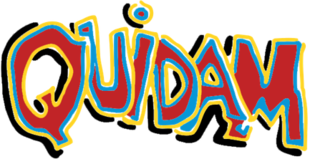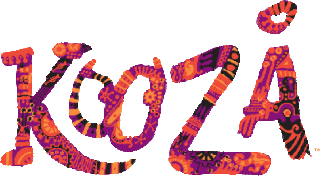
Quidam was the ninth stage show produced by Cirque du Soleil. It premiered in April 1996 and has been watched by millions of spectators around the world. Quidam originated as a big-top show in Montreal and was converted into an arena format beginning with its 2010 tour in North America. It then changed back to the Big Top for a 3-month run in Seoul, South Korea before returning to an arena show for its tour to Oceania. The show performed for the final time in Christchurch, New Zealand on February 26, 2016.
Saltimbanco was a touring show by Cirque du Soleil. Saltimbanco ran from 1992 to 2006 in its original form, performed under a large circus tent called the Grand Chapiteau; its last performance in that form was in Rio de Janeiro, Brazil, on December 10, 2006. A new adaptation of the show started touring North America on July 31, 2007, with its first stop in London, Ontario, Canada. The new version was staged in arenas with fewer performances in each city it visited. The new version closed at the end of 2012.

Alegría is a Cirque du Soleil touring production, created in 1994 by director Franco Dragone and director of creation Gilles Ste-Croix. It takes its name from the Spanish word for "joy".
Dralion was a touring production by the Canadian entertainment company Cirque du Soleil. The show combined elements of traditional Chinese circus with Western contemporary circus, complementing the "East-meets-West" theme implied in the title—the name is a portmanteau of "dragon" and "lion". It is Cirque du Soleil's twelfth touring production and the first Cirque show since 1985 not to be directed by Franco Dragone. Dralion performed its final show at the Sullivan Arena in Anchorage, Alaska on January 18, 2015, bringing its fifteen-year world tour to a close.
Mystère is one of six resident Cirque du Soleil shows in Las Vegas, Nevada. Held in a custom theatre at the Treasure Island Hotel and Casino, the show was first performed on 25 December 1993, making it the company's longest running show. As with many Cirque du Soleil productions, Mystère features a mixture of circus skills, dance, elaborate sets, opera, worldbeat music, and street theatre-style comedy. Featuring a musical score composed by René Dupéré and Benoît Jutras, the show was created under the direction of Franco Dragone.

La Nouba was a Cirque du Soleil show that ran for 19 years in a custom-built, freestanding theater at Disney Springs' West Side at the Walt Disney World Resort in Lake Buena Vista, Florida. It was a contemporary circus performance featuring acrobats, gymnasts, and other skilled performers. The show's creation was directed by Franco Dragone, who also directed many of Cirque du Soleil's earlier shows. Its title derives from the French phrase faire la nouba, meaning "to party" or "to live it up".
Corteo is a Cirque du Soleil touring production that premiered in Montreal, Quebec, Canada on April 21, 2005.

O is a water-themed stage production by Cirque du Soleil, a Canadian circus and entertainment company. The show has been in permanent residence at the Bellagio in Las Vegas, Nevada, United States, since October 1998. O, whose name is pronounced the same way as eau, the French word for "water", takes place around and above a 1.5-million-US-gallon (5,700 m3) pool of water. It features water acts such as synchronized swimming as well as aerial and ground acts. The O theatre, which is designed to resemble a 14th-century European opera house, has 1,800 seats, thus allowing the performance to be watched by 3,600 people a night since the performance usually plays twice in a given day, also designed to meet the special demands of the show.
Varekai was a Cirque du Soleil touring production that premiered in Montréal in April 2002. Its title means "wherever" in the Romani language, and the show is an "acrobatic tribute to the nomadic soul".

Nouvelle Expérience was Cirque du Soleil's fourth touring circus show, which premiered in 1990.

Zed was Cirque du Soleil's second resident show in Asia. It premiered on October 1, 2008 at the Cirque du Soleil Theater, Tokyo Disney Resort, in Urayasu, Chiba, Japan. Inspiration for Zed was taken from the Tarot and its Arcana; the main character Zed represents the Fool of the Tarot. The show depicted Zed's journey and his role in uniting two mythical groups, the people of the earth and sky. The production closed permanently on December 31, 2011.

Ovo is a touring circus production by Cirque du Soleil that premiered in Montréal, Canada in 2009. Ovo's creator and director, Deborah Colker, took inspiration from the world of insects. The idea for Ovo was not to be about the acts, nor dancing, nor insects, but about movement. The movement of life permeates the entire show, with creatures flying, leaping, bounding, and crawling. Composer Berna Ceppas brought additional life to Ovo with a score inspired by the music of Brazil. Ovo means "egg" in Portuguese and represents the underlying thread of the show. Graphically, inside the logo of Ovo, is an insect. The two O's represent the eyes and the V forms the nose and antennas.

Koozå is a touring circus production by Cirque du Soleil which premiered in Montréal, Quebec, Canada, in 2007. The show was written and directed by David Shiner, who had previously worked as a clown in Cirque du Soleil's production of Nouvelle Expérience. His experience as a clown and his time with Switzerland's Circus Knie and Germany's Circus Roncalli informed his work on Koozå.

Viva Elvis was the seventh resident Cirque du Soleil show on the Las Vegas Strip. It resided at the Aria Resort & Casino and premiered on February 19, 2010. The show closed on August 31, 2012. Cirque du Soleil partnered with Elvis Presley Enterprises to produce this show, similar to how they partnered with The Beatles' Apple Corps Ltd to produce the resident show Love at the Mirage.

Totem is a touring show by Cirque du Soleil that premiered in Montréal on April 22, 2010. It was written and directed by previous collaborator Robert Lepage (Kà). Cirque du Soleil describes Totem's theme as the evolution of humanity from its primordial, amphibian state toward the aspiration of flight, taking inspiration from many of humanity's founding myths. The show was awarded the 2013 New York Drama Desk Award for Unique Theatrical Experience.

Zarkana was a Cirque du Soleil stage production written and directed by François Girard. It began as a touring show in 2011 and was converted to a resident show in Las Vegas in late 2012. It premiered at Radio City Music Hall in New York City on June 29, 2011, and later toured to the State Kremlin Palace in Moscow and the Madrid Arena in Madrid.

Iris was a resident Cirque du Soleil show based in Los Angeles, California. It premiered on September 25, 2011, after preview performances which began on July 21, 2011. The cost for production of the show was nearly $100 million, which included the cost of renovating the Dolby Theatre in which the show was housed. Iris was written and directed by French director-choreographer Philippe Decouflé. The show explored images from the history of cinema and featured elaborate choreography, acrobatics, and a variety of contemporary circus acts. The name of the show, Iris, comes from the camera diaphragm as well as from the colored iris of the human eye.
Amaluna was a touring show by Cirque du Soleil. It was created and directed by Diane Paulus and is loosely inspired by The Tempest by William Shakespeare. It opened in Montréal, Quebec, Canada, on April 19, 2012. The cast is 70% female. They performed their last show in Sacramento, California, USA, on March 1st, 2020.

Joyà is an 80-minute long resident show at the Vidanta resort in the Riviera Maya, Mexico, produced as a collaboration between Cirque du Soleil and its subsidiary Cirque du Soleil Events + Experiences. It is Cirque du Soleil's first resident show in Latin America.













